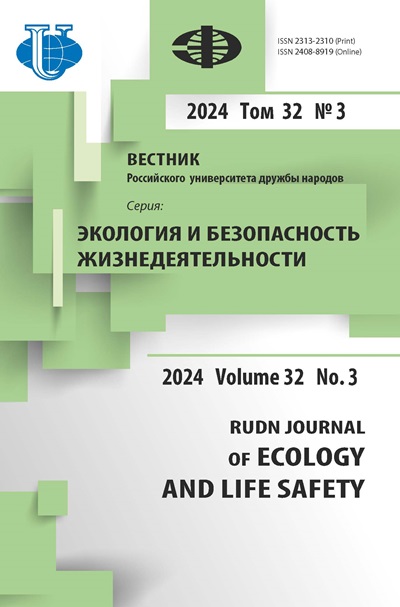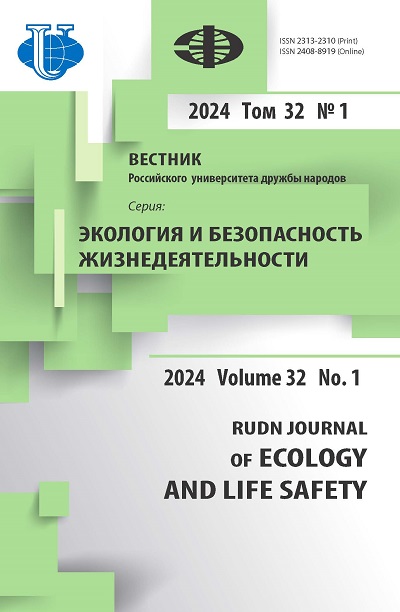Vol 32, No 1 (2024)
- Year: 2024
- Articles: 7
- URL: https://journals.rudn.ru/ecology/issue/view/1747
- DOI: https://doi.org/10.22363/2313-2310-2024-32-1
Full Issue
Ecology
Comparison of water levels of the Angrapa river in the middle of the 20th and early 21st century
Abstract
The results of a comparative analysis of the characteristic water levels in the Angrapa River (Berestovo gauging station, Kaliningrad region) in the middle of the 20th and at the beginning of the 21st century are presented. A number of average annual discharges of the Angrapa river (Berestovo gauging station) have been restored for analogue rivers. It has been established that the average long-term levels of the Angrapa river have decreased over the period under review. At the beginning of the 20th century, intra-annual changes in water levels with a spring flood peak, summer-autumn low water and rises during rain floods on the Angrape River were noted in less than half of the cases. In the 21st century, such a change occurs only in some years, in other years there are several rises in the water level, from December to March-April. The highest level in the Angrapa river (Berestovo gauging station) was recorded during a rain flood. The hydrological regime of a water body has a significant impact on the conditions for the existence of ecosystems, the level regime of a river significantly affects the floodplain ecosystem. The data obtained can be used in the development of environmental measures.
 7-15
7-15


Experimental evaluation of the protective properties of a humic preparation in relation to cultivated plants under salt stress
Abstract
In connection with the widespread problem of soil salinity, the issue of increasing the salt tolerance of cultivated plants is becoming increasingly important. In this aspect, humic substances and preparations based on them are very promising. The aim of the study was to evaluate the effect of humic preparations on agricultural crops and lawn cereals under salt stress. Under laboratory conditions, the protective properties of the humic preparation «Ekorost» were evaluated in relation to the industrial crop Brassica rapa L. and to lawn grasses under the influence of salt stress induced by excessive concentrations of sodium chloride and anti-icing agent. It was revealed that the humic preparation «Ekorost» exhibits protective properties in relation to the indicated test cultures under conditions of artificially simulated salt stress, which is expressed in a noticeable stimulation of their germination and growth processes. In all the experiments, the most effective was a 0.1% aqueous solution of the drug «Ekorost», which allows us to recommend it in the indicated dosage to increase the salt tolerance of oil radish ( Brassica rapa L.) and lawn cereals.
 16-31
16-31


Industrial Ecology
Technology for reducing gas emissions from livestock farms
Abstract
The study provides an overview of methods for neutralizing pollutants from emissions from livestock facilities. The principal possibility of gas purification with the use of sorbents based on natural materials is presented. Pilot tests were conducted on the territory of an operating livestock farm in the Republic of Kalmykia. During the experiment, the type of sorption loading of the biofilter varied, which made it possible to assess the basic requirements, engineering fundamentals, principles of operation, applicability, economic efficiency and potential failures of the proposed method.
 32-40
32-40


Studying the mechanism of action of new derivatives of quinoxalin-1,4-dioxide on the model organism Mycobacterium smegmatis
Abstract
According to the World Health Organization (WHO), antibiotic resistance is currently one of the most serious threats to human health, food security, and development. Tuberculosis (TB) remains one of the deadliest bacterial diseases. The primary challenge in treating tuberculosis infection is the emergence of strains with multidrug resistance (MDR) to 4-9 drugs. The emergence of bacterial strains with MDR is a consequence of patients’ insufficient adherence to treatment, interrupted therapy, improperly prescribed courses of chemotherapy, and, according to recent data, the accumulation of antibiotics in the environment, which can activate the natural drug resistance system in bacteria. The consequences of MDR to antibiotics include prolonged hospitalizations, increased medical expenses, and mortality. Therefore, the task is to develop new effective antibacterial agents with novel mechanisms to reduce the emergence of bacterial resistance. In this study, we investigated the mechanisms of action of new promising antimycobacterial derivatives of quinoxalin-1,4-dioxide on the model organism Mycobacterium smegmatis .
 41-50
41-50


Environmental Monitoring
Particular, the content of heavy metals in drinking water in the south of Central Siberia
Abstract
One of the conditions for the normal functioning of a living organism is a constant supply of clean and high-quality drinking water. This is also true for the population. Therefore, during the study, the characteristics of the content of heavy metals in drinking water in the south of Central Siberia were studied. During the work, the following tasks were solved: the content of heavy metals in drinking water was determined; the obtained values were compared with the maximum permissible concentrations of heavy metals; peculiarities of the content of heavy metals in various regions of the south of Central Siberia were identified. During the study, the following results were obtained. The water used for household and drinking needs by the population of the region is safe for use, since the maximum permissible concentrations for heavy metals are not exceeded. However, it can be noted that water samples taken in villages reveal a higher average content of the studied metals. The highest content in drinking water is typical for zinc, but the given values do not exceed the maximum permissible concentration for this element (5 mg/ml). The lowest content in the studied water samples is typical for mercury, the maximum permissible concentration for which is 0.0005 mg/ml.
 51-60
51-60


The efficiency assessment of short-term maximum flood level forecast methodology in the upper and middle course of the Tsna river
Abstract
A significant rise in water levels in the rivers during the spring flood and the release of rivers to the floodplain is the main danger in this period for nearby territories and people living there. This phenomenon can lead to flooding of large areas, significant economic losses, environmental damage, and threaten the health and life of local residents. Such negative consequences of high floods are typical for the Tambov region rivers, which indicates the need to develop an effective system for forecasting and preventing maximum flood levels. The climatic changes that have taken place over the past few decades, which are also reflected in the rivers’ water regime, show the need to modernize existing forecasting methodologies. In this paper, the authors have demonstrated the results of the effectiveness assessment of the existing methodology for short-term forecasting of the maximum flood level on the Tsna River at two gauging stations (“Kuzmino-Gat” and “Tambov”). Calculations were made using modern data in accordance with this methodology and a comparative analysis was carried out with the calculations of previous years. Based on this analysis, an assessment of the flood levels forecast methodology accuracy was given. According to the study results, it was found that the existing methodology for short-term forecasting of the maximum flood level on the Tsna River is largely ineffective nowadays with regard to modern conditions of spring flood runoff formation. In the analysis of the Kuzmino-Gat gauging station, the values of the maximum flood levels obtained by the reanalysis method according to the tested methodology using modern data showed significant deviations from the actual observed values. At the same time, for the operational forecast of maximum water levels at the Tambov gauging station, it is possible to use the correlation dependence with the observed water levels at the Kuzmino-Gat gauging station, as before. The correlation coefficient with modern data was 0.96. The authors have highlighted the main drawbacks of the existing methodology and made suggestions for improvement, in particular, what factors need to be analyzed in order to clarify the forecast.
 61-76
61-76


Biological resources
Horizons of biotechnology in Russia’s animal husbandry
Abstract
This study opens a series of articles on current trends in the development of innovative biotechnologies. They consistently describe the unlimited possibilities of the world of microorganisms - the microcosm, the mechanisms of which humanity can use for creative purposes, control and manage existing biotechnologies, applying them for the benefit of humanity. Adhering to the unshakeable opinion that the Microcosm is not a Warrior, the Microcosm is a worker…
 77-86
77-86
















